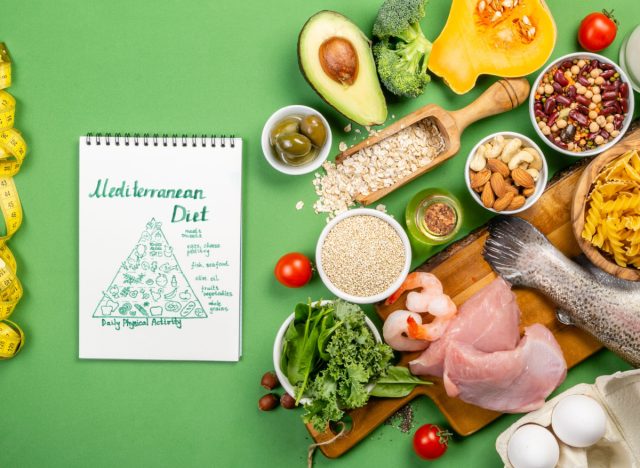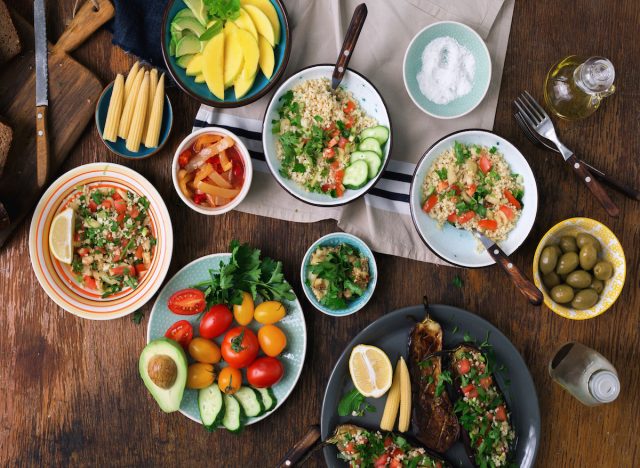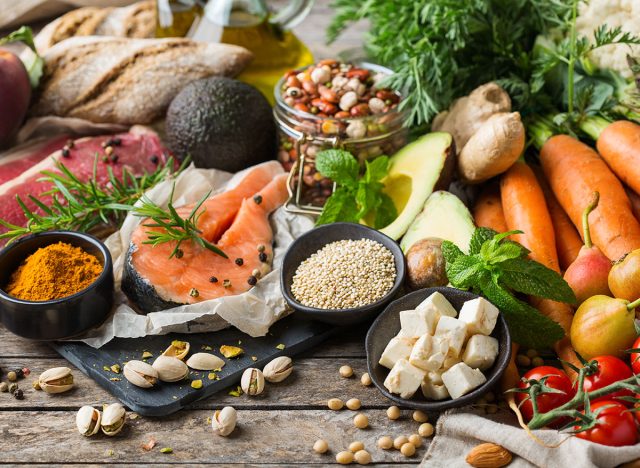10 Easiest Diets To Follow for Weight Loss, According to a Dietitian

Embarking on a new diet can be daunting, especially with the plethora of options available. However, some diets are not only effective but also relatively easy to follow, making them more sustainable to stick with in the long run. As a registered dietitian, I’ve seen firsthand which diets are the most manageable for people to incorporate into their lifestyles. From the Mediterranean diet to the DASH diet, we’ll explore the 10 easiest diets to follow for weight loss, backed by science and practicality, to help you achieve your health and wellness goals.
DASH

The DASH diet, which stands for Dietary Approaches to Stop Hypertension, is all about lowering blood pressure by eating lots of nutrient-rich foods and cutting back on sodium. It focuses on fruits, veggies, whole grains, lean proteins, and low-fat dairy while limiting saturated fats, cholesterol, and sweets.
Because it’s not super strict, you can still enjoy a variety of foods, making it simple to follow and easy to adjust to fit your taste preferences. Plus, it emphasizes whole, unprocessed foods, which can make meal planning easier.
Mediterranean

The Mediterranean diet is inspired by the traditional foods of countries around the Mediterranean Sea. It focuses on whole, minimally processed foods like fruits, veggies, legumes, nuts, whole grains, fish, and olive oil. It also allows for moderate amounts of dairy, poultry, and eggs while cutting back on red meat and sweets. In addition, research shows that the MedDiet is beneficial for those who want to lose weight and maintain a healthy weight.
The Mediterranean diet is easy to stick to because it prioritizes tasty, natural foods that are good for you. This makes meals more enjoyable and satisfying, which helps you stay on track. Plus, it’s flexible, so you can adjust it to fit your tastes and culture. This means you can enjoy a wide variety of foods, keeping your meals interesting and diverse.
MIND Diet

The MIND diet is a mix of the Mediterranean and DASH diets, designed to keep your brain healthy and lower your risk of Alzheimer’s and other forms of dementia. It prioritizes foods that are good for your brain, like berries, leafy greens, nuts, olive oil, whole grains, fish, poultry, beans, and a bit of wine. These foods are full of antioxidants, healthy fats, and other nutrients that support brain function and overall health.
Unlike other diets, the MIND diet is not super rigid, so it’s easier to stick with long-term. It’s all about adding more brain-healthy foods to your diet while gradually cutting back on less healthy options.
Low-fat

The low-fat diet is all about cutting back on fats, especially saturated and trans fats, while eating more complex carbs and lean proteins. It’s often recommended for heart health, weight management, and reducing the risk of certain cancers.
There are many low-fat options available in grocery stores and restaurants, making it convenient to find suitable foods. This accessibility helps people stay on track with their diet without feeling deprived or restricted in their food choices.
Additionally, a low-fat diet allows for flexibility in food choices, so individuals can still enjoy a variety of flavors and cuisines. Since it doesn’t require cutting out entire food groups, many people find it sustainable in the long term.
Vegetarian Diet

The vegetarian diet excludes meat, poultry, and fish but allows for dairy and eggs, depending on the type of vegetarianism. It’s rich in fruits, veggies, whole grains, legumes, nuts, and seeds, providing a wide range of essential nutrients. Interestingly, vegetarians often have lower risks of heart disease, high blood pressure, diabetes, and certain cancers compared to non-vegetarians.
One reason this diet is easy to stick with is the variety and flexibility it offers. With so many plant-based foods available, vegetarians can enjoy diverse and flavorful meals. Plus, many vegetarian dishes are quick and simple to prepare, making them convenient for busy lifestyles.
Plant-Based Diet

The plant-based diet focuses on whole, minimally processed plant foods like fruits, veggies, whole grains, legumes, nuts, and seeds while excluding animal products. It’s considered healthy because it’s high in fiber, which supports gut health and weight management, and low in saturated fat and cholesterol, which reduces the risk of heart disease.
With so many plant-based options available, you can create diverse and satisfying meals. Plant-based foods are often less expensive than animal products, making this diet cost-effective as well.
Flexitarian Diet

The flexitarian diet is mostly plant-based but allows for occasional meat and animal products. It focuses on fruits, veggies, whole grains, legumes, nuts, and seeds, with small amounts of meat, fish, dairy, and eggs. It’s considered healthy because it emphasizes nutrient-dense foods rich in vitamins, minerals, fiber, and antioxidants.
Unlike strict vegetarian or vegan diets, the flexitarian diet allows for occasional meat consumption, making it more sustainable for many people. Plus, the focus on whole, plant-based foods provides a wide variety of flavors and textures, making meals satisfying and enjoyable.
Volumetrics Diet

The volumetrics diet focuses on foods that are high in volume and low in calories, like fruits, veggies, whole grains, and lean proteins. It helps you feel full and satisfied while consuming fewer calories, promoting weight loss and maintenance without strict portion control or calorie counting.
It’s easy to follow because it allows you to eat a variety of food groups, with nothing necessarily “off-limits.” This flexibility can make it easier to stick with long-term, as you’re less likely to feel deprived. Plus, it emphasizes whole, minimally processed foods, making meal planning simpler.
Paleo

The paleo diet focuses on foods that were likely available to our ancient ancestors, like lean meats, fish, fruits, vegetables, nuts, and seeds, while cutting out grains, legumes, dairy, refined sugar, and processed oils.
This diet places an emphasis on whole, unprocessed foods, which can be more satisfying and filling than processed foods, help reduce cravings, and make it easier to stick to the diet long-term. Additionally, it doesn’t require strict calorie counting or portion control, so it can be more sustainable for some individuals.
Anti-inflammatory Diet

The anti-inflammatory diet is designed to reduce inflammation in the body, which is believed to contribute to many chronic diseases. This diet has no strict rules besides prioritizing whole, minimally processed foods rich in antioxidants and phytonutrients, like fruits, vegetables, whole grains, lean proteins, and healthy fats.
This diet is fairly flexible because it allows for a variety of foods and flavors, making it adaptable to different preferences and lifestyles.





